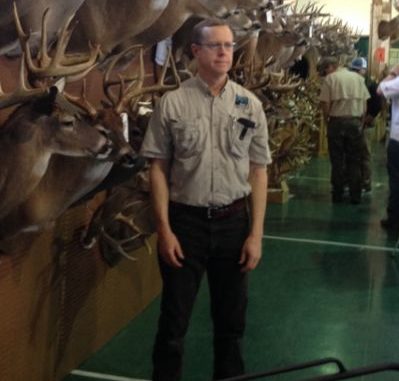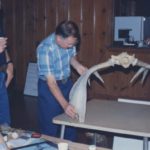
Just like every other hunter, I am overjoyed at the arrival of fall and another hunting season. We wait all summer for our favorite time of year, and when it finally arrives the hunt is on.
We go on those long-awaited and carefully planned trips. We get together at the camp with hunting buddies to renew old friendships. We take the kids and grandkids along for experiences they will always remember.
A lot of good things are part of hunting, and hunters do it for a variety of reasons. It is not always about the kill or the trophy, and personally the older I get, the truer that becomes.
But whether we admit it or not, in the backs of our minds every hunter hopes to bag that big buck, that huge bull.
We dream about the buck with the 20-inch spread and 10 or more long points. We long for the herd bull with massive antlers spanning the length of its back, with sword points thick as fence posts.
We might never take such a trophy, but we know it is out there somewhere and it’s one of the reasons we keep on hunting.
The good news is that exceptional trophies are taken each season, and quite a few great bucks are bagged right here in Louisiana.
News about a big buck travels fast, and invariably one of the first questions asked is “What’s he score?”
The answer to the question depends largely on who is doing the scoring and how they are going about it.
Which brings us to this month’s topic: Boone and Crockett Club measuring and scoring of North American big game.
Big-buck contests are sponsored and held everywhere deer are found. Some use scoring systems recognized only by the sponsor and those hunters who submit heads for entry in the contest. I know of a number of such contests held by sporting goods stores with scoring systems created within the store.
And that’s fine, as long as all the entries are scored in a consistent manner.
I have also seen individuals — landowners, for example — who create and use a system of their own to score deer taken on their land.
That’s OK, too, if they want to measure the head their way, hang it on the wall at home and say, “It scores 175 the way I do it.”
But the gold standard and most widely accepted measuring, scoring and records-keeping system is the Boone and Crockett Club’s Records of North American Big Game.
The Boone and Crockett Club was founded in 1887 by Theodore Roosevelt. Roosevelt and other early leaders in conservation could see the damage inflicted on wildlife by “humanity’s impact on wildlife and their habitat, and called people to action to change America’s direction.”
The North American Model for Wildlife Conservation resulted from the club’s early efforts in conservation.
In 1906, the club created the National Collection of Heads and Horns. It included examples of vanishing big game not only of North America but of the world.
In 1932, the first edition of Records of North American Big Game was published. The club has continued to publish records books and has held Big Game Awards Programs since the 1940s.
The scoring system was adopted in 1950. It is still the most-popular scoring system in the world, and is based on science and fair-chase principles.
The Pope and Young Club, which maintains records for bowhunting North American big game trophies, also utilizes the B&C scoring system and recognizes B&C official measurers as P&Y officials.
I encourage anyone who takes a mature buck with 8 points or more to at least unofficially or “green” score the rack using the B&C system. The hunter can easily do this on his own by going to the B&C website and following the instructions.
What I really like about the DIY process is it will automatically do the math. Just enter all the required measurements, and the calculations are done for you, providing gross and net scores.
Should your trophy score at or above the minimum for recognition by B&C, find an official measurer near you for an official score.
Just click on “Big Game Records” on the home page, and then “Find an Official Measurer,” for the list of 17 found in Louisiana. There is no charge for scoring; measurers serve voluntarily without compensation.
The current B&C Clubs 29th Big Game Awards Program, 2013-2015, includes entries received between Jan. 1, 2013 and Dec. 31, 2015. Due to the required 60 days drying period, the last day for a trophy to be harvested and still entered in the 29th Awards is Nov. 1, 2015.
Trophies taken after this date will be included in the 30th Awards Program.
One thing I have noticed on many occasions is the look of surprise and disappointment on the face of the hunter when the official measurer determines the trophy’s score.
All too often it is lower than expected because someone other than a trained measurer previously scored the head or it was green scored before 60 days of drying.
A common mistake is in determining the number of points. Many hunters have been told and incorrectly believe that “if you can hang a ring on it, it’s a point.”
However, a measureable point must be at least 1 inch in length and longer than the width of its base.
Another common error is in measuring the length of points. They are correctly measured from where they arise from the main beam, but many are measured from the middle or even the bottom of the main beam, resulting in length discrepancies.
And determining normal and abnormal points can be very confusing.
The Boone and Crockett Club’s “Field Guide to Measuring and Judging Big Game” has a lot of information about scoring and field judging everything in North America. Every serious hunter should own a copy.
Many of the measuring and scoring solutions for unusual or non-typical antler formations are explained, and the instructions for field judging trophy quality on the hoof are of great value.
The field judging methods are a must-read for any hunter before going West for pronghorn, mule deer or any other species with which he is unfamiliar.
The B&C Club also offers a number of other top-quality publications, such as Records of North American Big Game and Hunting the American West. They are well worth the reasonable prices. The list, along with costs and ordering instructions, can be found on the website.
Every hunter who believes in the ethics of fair chase should join B&C as an associate member. Four levels are offered: associate, sponsor associate, sportsman associate and lifetime associate.
Check the website for benefits and prices. Membership fees are used to fund B&C programs to protect hunting, promote wildlife conservation and educate the public.
Here is the best deal of all: If you harvest a buck this season, come on down to the Lamar-Dixon Expo Center in Gonzales next March for the Louisiana Sportsman Show and Festival.
Enter your buck in the Big Buck Contest. B&C official measurers will score the head.
And all contestants are eligible to win some nice prizes in a drawing — and there are winners in several categories including best Louisiana or Mississippi gun, bow or primitive weapon.
Good luck this fall and we hope to see you in Gonzales.




